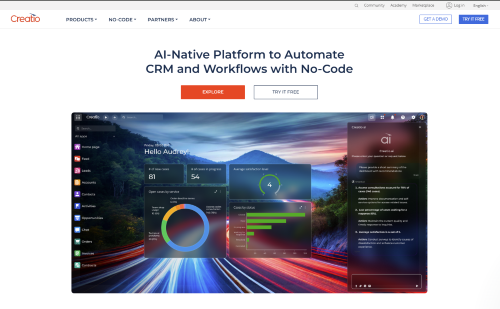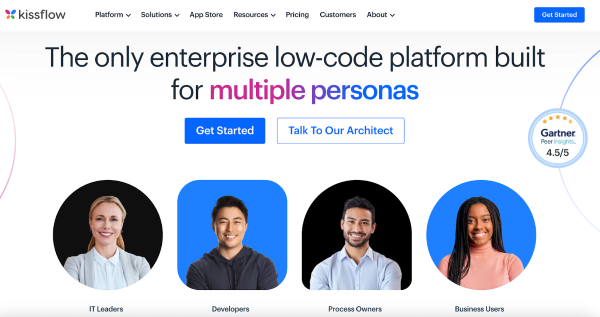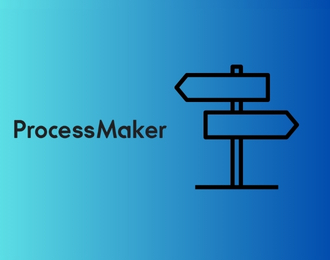A smooth and efficient client onboarding experience can set the tone for a long-lasting business relationship. But many organisations still rely on email threads, spreadsheets, and fragmented tools that create friction for both internal teams and new clients.
That’s where client onboarding software comes in — designed to streamline workflows, improve visibility, and deliver a seamless customer experience from day one.
In fact, the global market for client onboarding process software is projected to reach USD 6.28 billion by 2031, underscoring the growing demand for optimisation.
In this article, we’ll explore the top 10 client onboarding tools for 2025 and understand how FlowForma stands out with its intuitive, no-code automation and transparent pricing.
What is Client Onboarding Software?
.png?width=602&height=452&name=Blue%20Gray%20Minimalist%20Circle%20Teamwork%20Infographic%20Presentation%20Graphs%20(5).png)
Streamline client onboarding with an AI-powered process automation platform
Client onboarding software is a digital tool used by industries to streamline and automate the client onboarding process.
It helps businesses replace manual steps such as emails, spreadsheets, and physical forms with automated workflows and centralised data management. These platforms typically include form builders, workflow design, document generation, and analytics, all tailored to improve operational efficiency, compliance, and client experience.
Why Does Client Onboarding Software Matter in 2025?
In 2025, industries such as healthcare, finance, and construction require more efficient and compliant client onboarding processes to meet regulatory demands and enhance customer experiences.
The right user onboarding platform addresses this need by automating repetitive tasks, ensuring data accuracy, delivering faster onboarding cycles, and simplifying client interactions.
Top Client Onboarding Software in 2025: Quick Overview
Before going into details, here’s a side-by-side comparison of the best client onboarding tools available this year.
|
Product Name |
Best For |
Key Features |
Ease of Use |
Pricing |
Free Trial |
|
FlowForma |
Mid and large-sized businesses needing no-code automation |
No-code, AI Copilot, Microsoft 365 native |
Very easy for business users |
Process-based; Starts at €2,067 per month |
Yes (7 days) |
|
Creatio |
CRM + BPM integration |
CRM + BPM, AI tools, omnichannel engagement |
Medium |
From $25/user/month |
Yes |
|
Kissflow |
Small teams with simple workflows |
Forms, workflows, case management |
Easy |
From $1,500/month |
Yes |
|
Nintex |
Enterprises with complex workflows |
Advanced automation, eSignatures, document generation |
Medium to difficult |
Custom |
Yes |
|
Camunda |
Developers needing process orchestration |
BPMN engine, open-source, dev-first |
Difficult (developer-focused) |
Free + Enterprise |
Yes |
|
MS Power Platform |
Microsoft-centric organisations |
App builder, flows, Teams integration |
Easy (with Microsoft tools) |
Usage rights in M365 E3/E5; separate licensing for advanced use |
Yes |
|
Softr |
SMBs looking for simple, no-code solutions |
Airtable-based client portals, no-code UI |
Very easy |
$49 per month when billed annually, $59/month when billed monthly |
Yes |
|
Pipefy |
Operations teams needing visual workflows |
Kanban flows, SLAs, email automation |
Easy |
Not publicly disclosed. |
Yes |
|
Zoho Creator |
Businesses needing custom app building |
App builder, scripting, dashboards |
Medium |
From $8 per user per month |
Yes |
|
Tonkean |
Large enterprises with AI needs |
AI orchestration, enterprise operations |
Medium (AI-powered) |
Custom |
Yes |
Top Client Onboarding Software in 2025: Detailed Overview
Now that we’ve taken a quick look at the top user onboarding platforms, let’s dive into a detailed analysis of each tool.
1. FlowForma
FlowForma is an AI-powered process automation tool designed for business users to create, deploy, and refine client onboarding workflows without requiring IT support.
It combines forms, workflows, analytics, document generation, and AI agents in one unified platform.

Example client onboarding process created with FlowForma Copilot
FlowForma Key Features
1. No-code interface
FlowForma’s no-code platform allows business users to design and automate workflows without relying on developers. Its user-friendly interface empowers teams to rapidly digitise processes and scale automation independently.

Use Cases for No Code
2. Integration with existing systems
Seamless integration with Microsoft 365 (including SharePoint, Teams, and Outlook) enables users to collaborate effortlessly within the tools they already use. This native integration simplifies the transition, enhances user adoption, and reduces the need for extensive training.
 FlowForma offers seamless integrations
FlowForma offers seamless integrations
3. AI-powered automation
FlowForma’s AI Copilot and Agentic AI simplify client onboarding by offering powerful capabilities that transform how businesses handle workflows.
With AI Copilot, users can provide natural language instructions to build entire onboarding processes, such as client data collection, approval workflows, and document generation. This accelerates deployment and reduces reliance on IT.
Watch this demo to learn more.
Simplify onboarding processes in financial services with FlowForma
Additionally, Agentic AI offers intelligent, context-aware assistance throughout the onboarding process. It responds to user queries, suggests improvements, and ensures that each step flows seamlessly. Together, these AI tools make client onboarding faster, more efficient, and entirely user-driven.
4. Automated document generation
Critical documents such as contracts, forms, and approvals are automatically generated within the workflow. This eliminates the need for manual document creation, saving time and reducing the risk of errors.

Generate automated documents and ensure seamless client onboarding with FlowForma
5. Seamless compliance
FlowForma ensures regulatory compliance by incorporating built-in audit trails and compliance-ready logging. These features track every action taken during onboarding, ensuring full transparency and accountability across processes.
FlowForma Pros
- Fast deployment (under 6 weeks to ROI)
- No-code drag-and-drop interface for business users and IT
- Prebuilt templates for onboarding, approvals, and more
- AI-driven experience for process discovery and automation
- Flat process-based pricing, no hidden costs
- Robust analytics features
FlowForma Cons
- Requires a Microsoft 365 environment (SharePoint Online)
FlowForma Pricing
FlowForma offers a tiered, process-based pricing model. All core features, including AI Copilot and Agentic AI, are available across the three plans.
There are no surprise add-ons, which makes budgeting easier and ROI more predictable.
💡Case study in focus: How Ergo transformed its customer onboarding process using FlowForma
Ergo, a leading cloud and IT managed service provider in Ireland, faced challenges with client onboarding due to diverse business units using disparate systems. This led to inconsistencies in client information, multiple sources of truth, and a lack of visibility, which impacted the customer experience and accountability.
FlowStudy Summary for Ergo
To overcome onboarding challenges, Ergo implemented FlowForma Process Automation, integrating it with Microsoft SharePoint. This no-code solution enabled Account Managers to generate consistent agreements, establishing a single source of truth and automating client onboarding alerts for different departments.
As a result, Ergo boosted efficiency, ensured consistent onboarding, accelerated processes, and significantly improved customer experience, effectively managing substantial growth.
2. Creatio

Creatio’s homepage
Creatio is a low-code platform for process management and customer relationship automation.
It combines CRM functionalities with workflow orchestration and AI tools, making it suitable for businesses seeking to unify sales, service, and onboarding processes on a single platform.
Creatio Key Features
- Visual workflow and business rule designer
- CRM modules (sales, service, marketing)
- AI/ML for lead scoring and client behaviour prediction
- Self-service portals and client-facing forms
Creatio Pros
- Unified platform for CRM and process automation
- Scalable for complex workflows and large teams
- Built-in analytics and AI capabilities
Creatio Cons
- Requires some technical training for non-technical users
- Overkill for businesses that only need onboarding, not full CRM
- Licensing costs can scale quickly with features/modules
Creatio Pricing
Creatio follows a user-based pricing model, with prices starting at $25 per user per month (for CRM), and higher tiers available for process automation and studio customisation.

Creatio’s pricing page
3. Kissflow

Kissflow homepage
Kissflow is a low-code/no-code platform that enables teams to automate workflows, manage cases, and build apps. While it covers a broad range of business operations, it also includes a dedicated module for client onboarding.
Kissflow Key Features
- Form builder with custom validations
- Workflow templates for onboarding
- Role-based access and SLA tracking
- Custom reports and analytics
- Email-based approvals and reminders
- API access for advanced integration
Kissflow Pros
- Fast time-to-setup with templates
- Flexible for onboarding, procurement, and more
- Integration with Google Workspace, MS365, and Slack
Kissflow Cons
- Workflow complexity is limited at lower tiers
- Reporting features are basic without premium plans
Kissflow Pricing
Kissflow’s pricing starts at $1,500 per month for basic automation and includes support for up to 50 users. Advanced features (integration, AI, access control) are available in higher tiers. It also offers custom pricing for larger enterprises with more specific needs.

A look at Kissflow’s pricing page
4. Nintex
Nintex homepage
Nintex is a process automation platform that provides workflow automation, document generation, e-signatures, and analytics.
It is designed for use in regulated industries where process integrity and document compliance are essential. The platform offers enterprise integrations and eSignature capabilities, supporting onboarding scenarios that require detailed workflows and approval processes.
Nintex Key Features
- Workflow and form designer with advanced logic
- Built-in eSignature platform (Nintex Sign)
- Process mapping (Promapp) for documentation and SOPs
- Integrations with SharePoint, Salesforce, SAP, and more
Nintex Pros
- Provides support for compliance workflows
- Real-time dashboards and performance tracking
- Scalable for global teams and multi-department use
Nintex Cons
- Steep learning curve for non-technical users
- High total cost of ownership
- Requires IT involvement for customisation and scaling
Nintex Pricing
Nintex does not publicly reveal its pricing. It offers custom pricing based on your organisation’s requirements.
5. Camunda

Camunda’s homepage
Camunda is an open-source process orchestration platform designed for developers and technical teams to model, automate, and optimise complex business processes. It’s particularly suited for backend-heavy client onboarding systems that require tight control over execution logic and integration.
Camunda Key Features
-
Real-time monitoring and heatmaps
- REST and Java APIs
- Integration with Kafka, RabbitMQ, and other event brokers
- Kubernetes-native deployment options
- Plug-in architecture for extending behaviour
Camunda Pros
- Customisable and performant
- Open-source core with active developer community
- Suitable for mission-critical onboarding flows
- Scales well in distributed/cloud environments
Camunda Cons
- Not no-code or low-code — requires strong technical skills
- Lacks a built-in front-end/UI for business users
- Enterprise support and features are locked behind paid tiers
Camunda Pricing

Camunda’s pricing page
Camunda offers SaaS (cloud-hosted) and Self-Managed (user-hosted) plans, each with free tiers for basic use and custom-priced Enterprise tiers for advanced features.
6. Microsoft Power Apps + Power Automate
Microsoft’s Power Platform
Power Apps and Power Automate are part of Microsoft’s Power Platform. Together, they allow users to build custom apps (Power Apps) and automate workflows (Power Automate). They are often used in tandem for client onboareding use cases within the Microsoft 365 ecosystem.
Microsoft Power Platform Key Features
- Custom form and portal development via Power Apps
- Logic-based automation with Power Automate
- Microsoft Dataverse for storing onboarding data
- AI Builder for document processing and prediction
- Template gallery for basic onboarding flows
Microsoft Power Platform Pros
- Integrates with the Microsoft ecosystem
- Customisable with developer access
- Templates for common onboarding workflows
- Scalable through Azure and Dataverse
Microsoft Power Platform Cons
- Requires developer skills for anything beyond basic flows
- Multi-app architecture can become complex (e.g., Power BI, Power Pages)
- No centralised audit trail for multi-app onboarding processes
Microsoft Power Platform Pricing

Microsoft Power Apps Pricing

Microsoft Power Automate Pricing
Power Apps and Power Automate are typically licensed separately: Power Apps with a $20/user/month plan, and Power Automate with $15/user/month or $150-$215/bot/month plans.
The combined cost depends on the number of users, apps, and the level of automation required, with unattended processes incurring higher per-bot fees.
7. Softr

Softr homepage
Softr is a no-code platform that enables users to transform Airtable or Google Sheets data into client-facing web applications. It’s often used by small to mid-sized businesses to build onboarding portals, internal tools, and customer dashboards without writing code.
Softr Key Features
- Drag-and-drop builder for web apps
- Airtable/Google Sheets integration
- User authentication and roles
- Embedded payment, calendar, or third-party widgets
- Template library for portals and dashboards
- API access and Zapier integration
Softr Pros
- Fast setup with no development skills required
- Ideal for service-based SMBs
- Affordable entry point
Softr Cons
- Dependent on external databases (e.g., Airtable)
- Not suitable for regulated industries or complex compliance needs
- Lacks native reporting and analytics
Softr Pricing

Softr pricing
Pricing starts at $59 per month. Business and Enterprise plans offer custom branding and enhanced permissions.
8. Pipefy

Pipefy’s homepage
Pipefy is a no-code workflow management platform tailored for operations teams to automate repetitive processes, including client onboarding, procurement, and HR. It combines structured workflows, request tracking, and integrations into one customisable solution.
Pipefy Key Features
- Drag-and-drop workflow design
- Service level agreement (SLA) tracking and automation triggers
- Email templates and automated follow-ups
- Built-in reports and dashboards
- Integration with Slack, Salesforce, Zendesk, and more
- Custom scripts via Pipefy Apps for power users
Pipefy Pros
- User-friendly for operations and admin teams
- Clear visual workflow tracking
- Affordable for small and mid-sized businesses
Pipefy Cons
- Limited AI capabilities and advanced branching logic
- Requires manual configuration for advanced flows
- Not suited for highly regulated or developer-heavy environments
Pipefy Pricing

A look at Pipefy’s pricing plans
Pipefy does not disclose its pricing on its official website. According to G2, pricing starts at $26 per user per month for the Business plan.
9. Zoho Creator
Zoho Creator Page
Zoho Creator is a low-code app development platform that allows users to build custom applications, workflows, and onboarding portals with minimal coding. As part of the larger Zoho ecosystem, it integrates seamlessly with Zoho CRM, Zoho Books, and other Zoho products.
Zoho Creator Key Features
- Conditional logic and approvals
- Role-based access and workflows
- Real-time analytics dashboards
- Deluge scripting for automation and calculations
- REST APIs and native integrations with other Zoho apps
Zoho Creator Pros
- Seamless integration with Zoho CRM and other tools
- Allows deeper customisation through scripting
- Multi-language and offline app support
Zoho Creator Cons
- Requires technical knowledge for complex logic
- UI less polished compared to newer no-code tools
- Support and learning resources can be inconsistent
Zoho Creator Pricing

Zoho Creator Pricing as seen on G2
According to G2, pricing for Zoho Creator starts at $8 per user per month for basic plans. Higher tiers offer advanced features, automation, and multi-user management.
10. Tonkean
Tonkean Homepage
Tonkean is a no-code platform built for operations teams. It specialises in orchestrating complex, human-in-the-loop workflows across departments — including client onboarding — without requiring engineering support.
Tonkean Key Features
- Visual Workflow Builder with logic and AI steps
- Human-in-the-loop process orchestration
- Slack/MS Teams-based task engagement
- AI for task classification and escalation
- Real-time reporting and dashboards
- Integration with 1000+ apps via API or no-code connectors
Tonkean Pros
- Facilitates cross-departmental onboarding processes
- Integrates with the tools teams already use
- Great for Ops-led automation at scale
Tonkean Cons
- Higher learning curve for non-technical users
- Pricing not publicly disclosed, and can be expensive for small teams
Tonkean Pricing
Custom pricing only. Requires contact with Tonkean sales for a tailored enterprise quote.
Features to Look For in Your Client Onboarding Software
.png?width=602&height=452&name=Blue%20Gray%20Minimalist%20Circle%20Teamwork%20Infographic%20Presentation%20Graphs%20(7).png)
Features to look for in client onboarding software
Choosing the right client onboarding tool starts with understanding the non-negotiable features that address real-world operational pain points. Below are the most essential capabilities your software must include:
1. Workflow automation
Workflow automation is the foundation of any efficient onboarding system. It allows you to digitise and streamline multi-step processes such as approvals, task routing, and reminders, removing the burden of manual follow-up. Without automation, businesses face inconsistent onboarding experiences, increased human error, and long time-to-value cycles.
With FlowForma, for example, users can create dynamic, logic-based onboarding workflows without writing a single line of code — dramatically reducing the dependency on IT and enabling rapid deployment.
2. Form and document management
Capturing accurate client information is a key requirement for onboarding, and your software must offer strong form-building and document-handling capabilities.
A look at FlowForma’s Dynamic Form Builder
Whether it’s identity verification, terms and conditions, or KYC compliance, the tool should enable easy data collection and seamless document generation. If these features are lacking, organisations risk data fragmentation, compliance violations, and poor customer experience.
3. Integration capabilities
.png?width=484&height=363&name=Blue%20Gray%20Minimalist%20Circle%20Teamwork%20Infographic%20Presentation%20Graphs%20(9).png)
Ensure seamless integration with existing systems with FlowForma
Your onboarding software must integrate with other core systems like CRM, ERP, e-signature solutions, and ID verification platforms to avoid duplicate data entry and manual handovers.
Seamless integration means information flows automatically across systems, increasing data accuracy and freeing up staff for higher-value work.
4. Compliance and audit trail
In regulated industries such as healthcare, finance, insurance, or legal, your onboarding software must support compliance by offering robust audit trails and permission control.

Support compliance in client onboarding with FlowForma
Look for tools that offer built-in audit trails and support regulations like the Digital Operational Resilience Act (DORA) and the General Data Protection Regulation (GDPR).
5. AI-driven experience
Your onboarding software should utilise AI to accelerate workflow creation, provide intelligent recommendations, and facilitate contextual decision-making. Traditional tools often require extensive manual configuration, which slows innovation.
FlowForma’s AI Copilot enables users to create onboarding workflows using either natural language or uploaded diagrams. Watch this video to learn more.
FlowForma’s AI Copilot helps build workflows with ease
The tool also includes summarisation agents that provide users with intelligent recaps at any point in the process, dramatically reducing the need for status meetings or document digging.
Pricing transparency & scalability
Look for clear and straightforward pricing models, ideally flat rates per active user or process, with transparent upgrade paths. This approach helps avoid hidden costs and financial surprises as your onboarding needs evolve and expand.
Accelerate Client Onboarding with FlowForma’s No-Code Automation

Choosing the right client onboarding software in 2025 can be the difference between frustrated clients and streamlined success.
Whether you're a startup scaling rapidly or an enterprise managing complex compliance, the top tools we’ve explored each bring something valuable to the table — from fast setup and ease of use to robust customisation and enterprise-grade security.
FlowForma stands out as a best-in-class option for mid-sized businesses to large enterprises seeking:
- Rapid, no-code implementation
- Transparent pricing with no hidden fees
- AI-powered process building and optimisation
- Seamless Microsoft 365 integration
- High adoption across business users
With a time-to-value of under six weeks and proven ROI across industries such as construction, healthcare, and financial services, FlowForma enables teams to do more with less, without writing a single line of code.
Ready to streamline your client onboarding experience? Book a demo today!
FAQs
What is the best customer onboarding software for Microsoft 365 users?
FlowForma is purpose-built for Microsoft 365, offering native integration with SharePoint, Outlook, and Teams, making it ideal for M365 environments.
Do these platforms offer automation for document generation and approvals?
Yes, platforms like FlowForma are particularly strong in automating document-based workflows, including contracts and KYC processes. This makes it easier to collect customer data, generate onboarding documents and establish clear workflows.
What integrations should I look for when considering a client onboarding tool?
Make sure the software integrates with your CRM, ID verification, storage, and communication platforms. For example, FlowForma integrates directly with Microsoft 365, DocuSign, and REST APIs for broader use.
.png) By
By 









